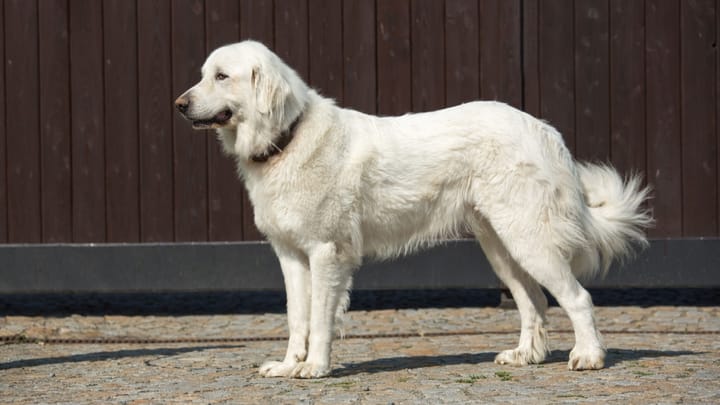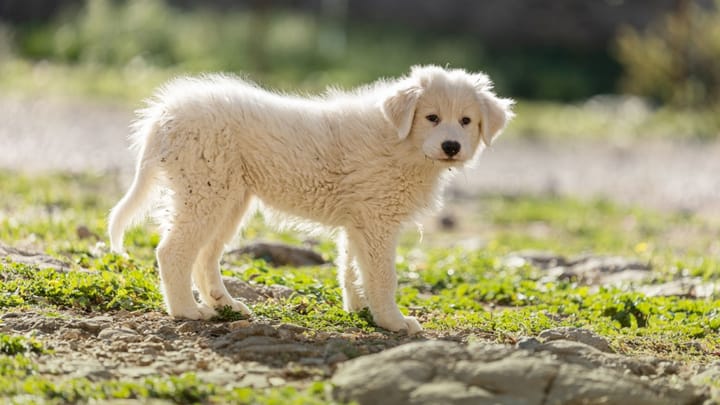Pyrenean Mountain Dog
Other name: Great Pyrenees


The Great Pyrenees is a large, powerful dog. Breed to guard sheep and other livestock, the Great Pyrenees is a brave and fearless animal. This dog will quickly confront any perceived threats to the pack but displays gentle and affectionate behaviours towards it other members. The Great Pyrenees is a bit of night owl and has a tendency to bark late at night, especially if they haven't “unlearnt” this instinctual behaviour. Like the majority of large working breeds, this dog is smart but stubborn. These strong-willed dogs need a confident and experienced handler.
|
Life expectancy |
The Pyrenean Mountain Dog has a life expectancy of between 10 and 12 years |
|
Temperament |
|
|
Size |
Large
|
|
Adult size |
Female
Between 26 and 30 in
Male
Between 28 and 31 in
|
|
Adult weight |
Female
Between 110 and 130 lb
Male
Between 123 and 141 lb
|
|
Coat colour
A Great Pyrenees will usually have a brilliant white coat, although it can also be cream, tan, or light grey. |
White |
|
Type of coat
A thick, fluffy undercoat. A long and straight outer coat. Double coated. |
Long |
|
Eye colour
Amber brown. |
Brown
|
|
Purchase price |
The Pyrenean Mountain Dog costs between £960 and £980 |
Like many larger dogs, the Great Pyrenees is sensitive to anaesthesia. Given that they're a fairly rare breed, make sure your vet is aware of this before performing any surgical procedures.
The Great Pyrenees has a unique double dewclaw. This should only ever be trimmed and never removed.
Unlike most other breeds, the Great Pyrenees has nocturnal tendencies. They can become quite active at night and have a tendency to bark a lot.
More details about the Pyrenean Mountain Dog
Pyrenean Mountain Dog: Origins and history
The Great Pyrenees was developed in and around the Pyrenean mountain range. They were used as both guard dogs and sheepdogs. They would herd the flocks during the day and then switch over to guard duties during the evenings. This explains their nocturnal behaviour and tendency to bark during the night. The Great Pyrenees is still more of a working dog than a domesticated canine, although they're popularity is slowly starting to grow, especially among active dogs lovers living in more rural environments.
Physical characteristics of the Pyrenean Mountain Dog
The Great Pyrenees is a large, imposing dog with a confident posture and measured gait. They have deep, powerful chests, a long body, and powerful hindquarters. Their thick white coat gives them a “softer” look, although these tough dogs should never be underestimated. The fur is much more profuse around the neck area, especially in males, and they have a long, curved tail that hangs down quite low.
FCI classification of the Pyrenean Mountain Dog
-
Group 2 - Pinscher and Schnauzer - Molossoid and Swiss Mountain and Cattledogs
-
Section 3 : Swiss Mountain and Cattledogs
Pyrenean Mountain Dog: Characteristics
Pyrenean Mountain Dog: Behaviour
Training a Pyrenean Mountain Dog
This depends on the ability and knowledge of the trainer. An inexperienced handler will have a very tough time keeping this dog focused. In fact, if you've haven't trained a pet before, then the Great Pyrenees is not the right dog to start with.
Pyrenean Mountain Dog: Lifestyle
Breed compatibility Pyrenean Mountain Dog
Pyrenean Mountain Dog: Purchase price
The average cost of a purebred Great Pyrenees is somewhere between £960-£980.
You'll also need to budget around £100 a month for feeding costs, and the average cost of a basic insurance policy is around £20.00 per month, although this varies from dog to dog.
Pyrenean Mountain Dog: Shedding
Average
Although they shed quite regularly, they’re not at risk of any permanent hair loss.
Pyrenean Mountain Dog: Grooming
The Great Pyrenees is a medium to heavy shedding breed, especially during the warmer times of the year. Their pure white coats will need a weekly brush, and you'll need to pay close attention to the extra fluffy parts around the neck and tail. They do a pretty good job of keeping themselves clean, although they will a bath once every 8 weeks or so.
Pyrenean Mountain Dog: Health
The average lifespan for these dogs is between 10-12 years.
The Great Pyrenees is one of the most robust breeds. These strong, sturdy dogs were developed for the great outdoors and are well equipped to thrive in harsh weather conditions and inhospitable environments. They're brave, tough, and independent.
These dogs were not designed for warmer climates and may struggle in very hot temperatures. They do shed during the warmer months but avoid exercising then during the hottest parts of the day.
The Great Pyrenees has a thick, insulating undercoat covered by a long, weather resistant outer layer. They have no problems getting through the average British winter.
The Great Pyrenees isn’t prone to obesity or weight gain. Still, they will pile on a few extra pounds if you let them. So feed them the right amounts and make sure they’re getting the right amount of exercise.
- Addison’s disease
- Hip Dysplasia
- Cataracts
- Entropion
- Patellar luxation
- Gastric Torsion





